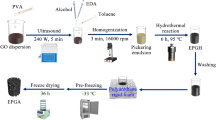Abstract
Freeze casting is a very simple, inexpensive, and environmentally friendly method for the production of porous materials. In this method, the suspended particles are concentrated and compressed together as ice crystals grow so that the walls of particles will form between the ice crystals. After sublimation of ice, only the colloidal aggregate particles will remain without collapsing. In this study, by drying of graphene hydrogel using freeze casting under ambient pressure, the final pore size of graphene aerogels was controlled. Three types of graphene aerogels were prepared with three different freezing rates of 2, 1 and 0.64 °C/min. The results showed that by decreasing the cooling rate, the average pore size increased from 35.6 to 43.4 μm and the density decreased from 50 to 40 mg/cm3. The effect of freezing rate on the formation of controlled residual pores and some physical properties of graphene aerogels such as absorption capacity of gas oil, kerosene, cooking oil and ethanol was investigated.





Similar content being viewed by others
References
Notarianni M, Liu J, Vernon K, Motta N (2016) Synthesis and applications of carbon nanomaterials for energy generation and storage. Beilstein J Nanotechnol 7(1):149–196
Winzer T, Knorr A, Malic E (2010) Carrier multiplication in graphene. Nano Lett 10(12):4839–4843
Tajiki A, Abdouss M (2017) Synthesis and characterization of graphene oxide nano-sheets for effective removal of copper phthalocyanine from aqueous media. Iran J Chem Chem Eng (IJCCE) 36(4):1–9
Bryning MB, Milkie DE, Islam MF, Hough LA, Kikkawa JM, Yodh AG (2007) Carbon nanotube aerogels. Adv Mater 19(5):661–664
Worsley MA, Pauzauskie PJ, Kucheyev SO, Zaug JM, Hamza AV, Satcher JH Jr, Baumann TF (2009) Properties of single-walled carbon nanotube-based aerogels as a function of nanotube loading. Acta Mater 57(17):5131–5136
Job N, Théry A, Pirard R, Marien J, Kocon L, Rouzaud JN, Béguin F, Pirard JP (2005) Carbon aerogels, cryogels and xerogels: influence of the drying method on the textural properties of porous carbon materials. Carbon 43(12):2481–2494
Deville S (2013) Ice-templating, freeze casting: beyond materials processing. J Mater Res 28(17):2202–2219
Yang H, Zhang T, Jiang M, Duan Y, Zhang J (2015) Ambient pressure dried graphene aerogels with superelasticity and multifunctionality. J Mater Chem A 3(38):19268–19272
Scotti KL, Dunand DC (2018) Freeze casting–A review of processing, microstructure and properties via the open data repository, FreezeCasting. net. Prog Mater Sci 94:243–305
Li WL, Lu K, Walz JY (2012) Freeze casting of porous materials: review of critical factors in microstructure evolution. Int Mater Rev 57(1):37–60
Miller SM, Xiao X, Faber KT (2015) Freeze-cast alumina pore networks: effects of freezing conditions and dispersion medium. J Eur Ceram Soc 35(13):3595–3605
Deville S, Saiz E, Tomsia AP (2007) Ice-templated porous alumina structures. Acta Mater 55(6):1965–1974
Farbod M, Shojaeenezhad SS (2019) A three-dimensional Ag nanoparticle/graphene hydrogel composite and its application as an improved supercapacitor’s electrode. J Solid State Electrochem 23(11):3009–3017
Liu Y, Qian W, Zhang Q, Cao A, Li Z, Zhou W, Ma Y, Wei F (2008) Hierarchical agglomerates of carbon nanotubes as high-pressure cushions. Nano Lett 8(5):1323–1327. https://doi.org/10.1021/nl0733785
Wang C, Yang S, Ma Q, Jia X, Ma PC (2017) Preparation of carbon nanotubes/graphene hybrid aerogel and its application for the adsorption of organic compounds. Carbon 118:765–771
Acknowledgements
The authors would like to acknowledge Shahid Chamran University of Ahvaz for the financial support of this work.
Author information
Authors and Affiliations
Corresponding author
Ethics declarations
Conflict of interest
I declare that the paper I am submitting is not currently submitted for review to any other journals and will not be submitted elsewhere before a decision is made by this journal. Also, I declare the manuscript has been approved by all co-authors and no financial or non-financial conflict exists.
Additional information
Publisher's Note
Springer Nature remains neutral with regard to jurisdictional claims in published maps and institutional affiliations.
Rights and permissions
About this article
Cite this article
Farbod, M., Madadi Jaberi, M. Effect of cooling rate on the microstructure absorption capacity of oil-based materials of graphene aerogels prepared by freeze casting at ambient pressure. Graphene and 2D mater 7, 45–50 (2022). https://doi.org/10.1007/s41127-022-00047-x
Received:
Revised:
Accepted:
Published:
Issue Date:
DOI: https://doi.org/10.1007/s41127-022-00047-x




